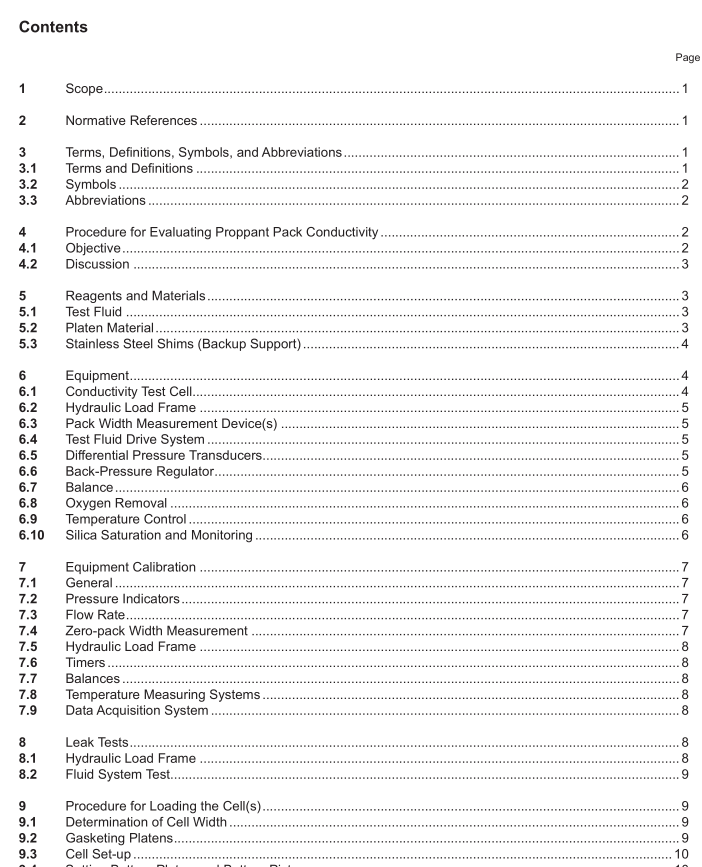API RP 19D pdf download

API RP 19D pdf download Measuring Conductivity of Proppants
4.2 Discussion In this procedure, a closure stress shall be applied across a test cell for 50 h ±2 h to allow the proppant sample bed to reach a semi-steady state condition. As the fuid is forced through the proppant bed, the proppant pack width, diferential pressure, temperature, and fow rates are measured at each stress level. Proppant pack conductivity parameters and width are measured, and permeability is calculated. Multiple fow rates are used to verify the performance of the transducers, and to determine laminar (darcy) fow regime at each stress; an average of the data at these fow rates is reported.
For highest data accuracy, a minimum pressure drop of 0.014 kPa (0.0020 lbf/in. 2 ) shall be used; otherwise, fow rates should be increased to achieve the minimum pressure drop. Alternatively, for smaller proppants with lower conductivities, measurements shall use a pressure transducer with larger pressure span, to increase accuracy in measurements of higher pressure drop but which will reduce accuracy at smaller pressure drop values. At stipulated fow rates and temperature conditions, no appreciable non-darcy fow or inertial efects are encountered. After completing the rates at a closure stress level in all cells, the closure stress is increased to a new level; 50 h ±2 h is allowed for the proppant bed to reach a semi-steady state condition, and multiple fow rates in all cells are introduced to gather data required to determine proppant pack conductivity at this stress level. The procedure is repeated until all desired closure stresses and fow rates have been evaluated. To achieve accurate conductivity measurements, it is essential that single-phase fow occurs. Test condition parameters, such as test fuid, temperature, loading, platen material and time, at each stress are reported along with conductivity and permeability data. Other conditions can be used to evaluate diferent characteristics of proppants and, therefore, can be expected to produce difering results. 5 Reagents and Materials 5.1 Test Fluid The test fuid shall be 2 % w/w (0.274 mol/kg) potassium chloride (KCl) in a deionized or distilled water solution fltered to 7 µm (0.0003 in.) or smaller . The potassium chloride shall be at least 99 % by mass pure (Chemical Abstracts Service (CAS) No.7447-40-7).
5.2 Platen Material
5.2.1 Stone platens Sandstone or naturally occurring stone platens shall have dimensions of 176.80 mm to 177.80 mm (6.960 in. to 7.000 in.) in length, 37.70 mm to 38.10 mm (1.485 in. to 1.500 in.) wide, and a minimum of 8.10 mm (0.320 in.) thickness. The ends of the platen shall be rounded to ft into the test cell (see 6.1). Platen parallelism shall be maintained to ±0.03 mm (±0.001 in.) of platen length. The preferred sandstone platen material should comprise Buena Vista sandstone 2 from Scioto County, Ohio (USA). Any other rock material used for these measurements shall be documented, including the physical properties of the material and place of origin. Representative properties for Buena Vista sandstone are summarized in Table 1. NOTE Buena Vista sandstone is a homogeneous quartzose fne-grain rock.
5.2.2 Stainless Steel 316 Platens (316 ss)
316 SS or equivalent material platens should be used as an alternative to sandstone platen. Alternative platenscan produce substantially different results compared with sandstone.For example,316 SS platens may producehigher conductivitylpermeability values due to minimal proppant embedment. When used, test results shall beclearly marked as using a specific grade of 316 SS platens. 316 SS platens, in contact with the proppant bed,shall have dimensions and shape identical to stone platens as stated in 5.2.1 [length:176.80 mm to 177.80 mm(6.960 in. to 7.000 in.), width:37.70 mm to 38.10 mm (1.485 in. to 1.500 in.).As an alternative, a minimum of1.40 mm (0.055 in.) thick disposable metal platen should be used in contact with the proppant supported byanother 316 SS platen of a minimum of 6.70 mm (0.265 in.) thickness, contingent on the abilities of the 316 ssplaten and piston to fit properly into the cell body. The ends of the 316 SS platens shall be rounded to fit into thetest cell. Platen parallelism shall be maintained to +0.03 mm (10.001 in.) of platen length.
In the event of visible surface anomalies, 316 SS platens shall be returned to machine shop for resurfacinglrepairto the original surface condition. Platens of 8.90 mm (0.350 in.) thickness should be desired for platens intendedto be resurfaced and reused. Visible surface anomalies, such as pitting or machine marks, may be present oneither new or reused metal platens and shall be repaired before use of those (new or reused) metal platens.lf any 316 ss equivalent platens were used material properties shall be reported.
5.3Stainless Steel Shims (Backup Support)
316 sS or equivalent material shims should provide additional support for the stone platens and the seal ring atelevated stress where native stone platens tend to flex and crack or even break.Shims as noted in Figure C.1shall have dimensions of 176.80 mm to 177.80 mm (6.960 in. to 7.000 in.) in length,37.70 mm to 38.10 mm(1.485 in. to 1.50 in.) wide, and a minimum of 3.05 mm (0.120 in.) thick. The ends of the 316 SS shims shall berounded to fit into the test cell.Shim parallelism shall be maintained to 10.03 mm (10.001 in.) of shim length.lf any 316 ss equivalent shims were used, material properties shall be reported.









